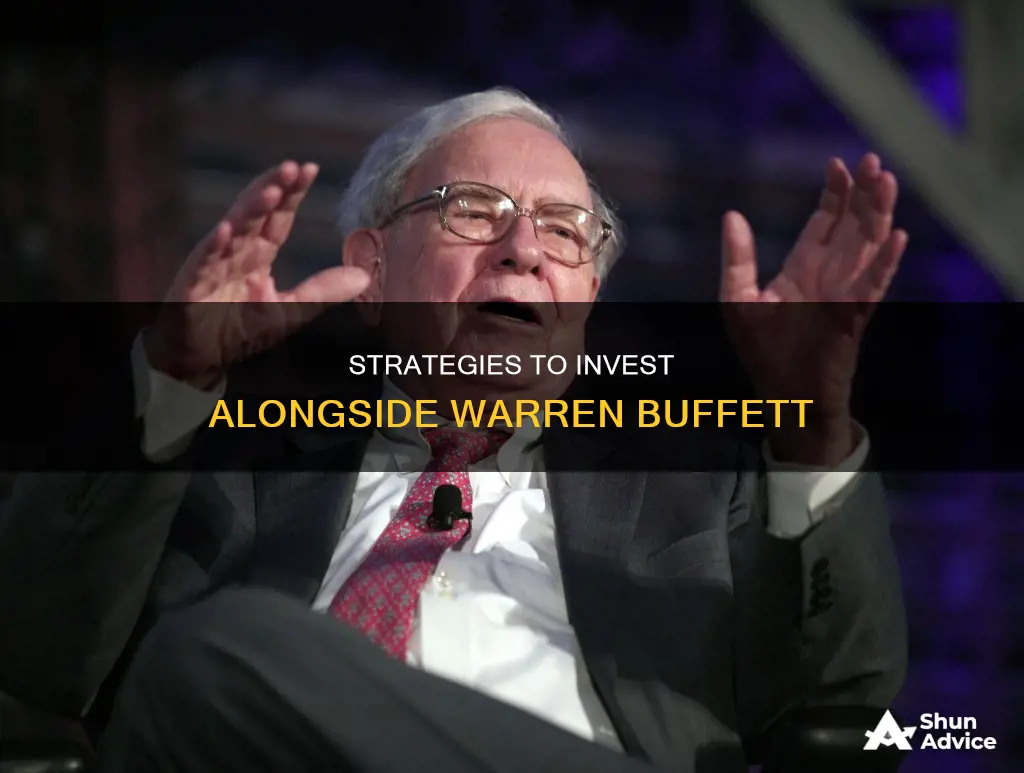
Warren Buffett is one of the world's most successful investors, with a net worth of over $130 billion as of July 2024. His investment strategy has reached almost mythical status, and many investors track changes in his portfolio as a guide for their own choices.
Buffett's approach to investing is not overly complicated. He advises buying businesses, not stocks, and looking for companies with competitive advantages that can be maintained. He focuses on long-term intrinsic value, not short-term earnings, and prioritises a margin of safety by buying companies for less than their intrinsic values.
Buffett's top holdings include Apple, Bank of America, American Express, Coca-Cola, and Chevron.
If you want to invest in Warren Buffett's funds, you can follow his investment strategy and look for companies that fit his criteria. Alternatively, you can invest in the stocks that he holds in his portfolio, such as those mentioned above.
What You'll Learn

Buy businesses, not stocks
Warren Buffett's investment strategy is centred on the principle of buying businesses, not stocks. This means that instead of focusing on the supply-and-demand intricacies of the stock market, Buffett looks at companies as a whole. He chooses stocks based on the overall potential of a company as a business, rather than as a vehicle for short-term capital gains.
Buffett advises investors to always weigh and analyse the business behind a stock. He suggests focusing on businesses that you understand and have some knowledge of, as this will help you assess where a company is going, not just where it has been and where it currently stands. This approach helps identify companies that are undervalued by the market or not recognised by the majority of buyers.
Buffett himself once passed on investing in Google and Amazon because he admitted he didn't have a firm knowledge of the internet industry, which made it difficult for him to analyse their stocks. This highlights the importance he places on truly understanding the business and industry a company operates in before investing.
When deciding whether to invest in a company, Buffett considers various factors, including company performance, debt, and profit margins. He also takes into account whether a company is public, how reliant it is on commodities, and how cheap it is.
By following this "buy businesses, not stocks" approach, Buffett has achieved tremendous success as one of the world's most renowned investors, amassing a fortune over several decades.
Endowment Funds: A Smart Investment for Your Future
You may want to see also

Focus on long-term intrinsic value, not short-term earnings
Warren Buffett's investment strategy is not overly complicated. One of his key tenets is to focus on long-term intrinsic value, rather than short-term earnings.
Buffett's approach is to view himself as a business owner, not a stock owner. He looks at the overall health of a company, its deficiencies and its strengths, rather than focusing on a stock price. He is interested in how much cash a company can generate for its owners in the future, so he values companies using a discounted cash flow analysis.
Buffett is a strong advocate of the Benjamin Graham school of value investing, which looks for securities with prices that are unjustifiably low based on their intrinsic worth. He is not concerned with the supply-and-demand intricacies of the stock market, but rather the overall potential of a company.
Buffett's focus on long-term value means he is not interested in short-term gains. He is happy to hold stocks for years, or even decades. He is a buy-and-hold investor, patiently building stock positions over time.
Buffett's long-term mindset is reflected in his famous quote: "If you aren't willing to own a stock for 10 years, don't even think about owning it for 10 minutes."
Index Funds: When to Invest for Maximum Returns
You may want to see also

Embrace market downturns
Warren Buffett's investment strategy is renowned and often referred to as
Identify Strong Businesses with Long-Term Value:
Look for well-established companies that have successfully navigated recessions and down markets in the past. These businesses should have manageable debt, reliable cash flow, disciplined leadership, and a history of strong performance.
Be Patient and Ready to Act:
Market downturns and panics are inevitable. Prepare yourself financially and psychologically to take advantage of these opportunities. Have a watchlist of quality companies you'd like to invest in, and be ready to act when their stock prices drop.
Buy When Others Are Panicking:
This requires courage and conviction. Block out the noise of panic-selling and stick to your valuations. Focus on the long-term fundamentals of the business rather than short-term stock volatility.
Focus on Long-Term Fundamentals:
Buffett's strategy involves buying high-quality stocks and holding them for as long as possible. He is famous for his loyalty to companies that demonstrate long-term excellence. He once said, "If you aren't willing to own a stock for ten years, don't even think about owning it for ten minutes."
Understand Business Fundamentals:
Buffett examines a company's fundamental strengths and weaknesses to ensure he only invests in high-quality stocks. He looks at factors such as performance over time, debt management, resources to survive downturns, and the ability to generate earnings.
Take Advantage of Discounted Prices:
Market downturns offer the opportunity to buy valuable stocks at discounted prices. Buffett embraces these opportunities, knowing that the market will eventually recover, and high-quality companies will rise again.
Have a Long-Term Investment Horizon:
Buffett's approach is not about short-term gains. He focuses on the long-term potential of businesses, holding his investments for years or even decades.
By following these principles, you can emulate Warren Buffett's contrarian investing strategy and potentially achieve successful long-term investment outcomes.
The Future Fund: Investing in Tomorrow's Opportunities
You may want to see also

Learn the basics of value investing
Warren Buffett is widely considered to be the world's greatest value investor. Here are the basics of value investing:
Value investing is a strategy that prioritises paying low prices for investments relative to their intrinsic values. The goal of a value investor is to buy $100 worth of a company's stock for less than $100. Value investors seek out and invest in companies with intrinsic values greater than the enterprise values implied by the trading prices of their stocks. They expect that the market will eventually recognise the full value of an undervalued company, resulting in an increase in the company's stock price and profits for the value investor.
Warren Buffett follows the Benjamin Graham school of value investing. He looks at companies holistically, focusing on their overall potential rather than the supply-and-demand intricacies of the stock market. He buys quality companies trading for less than their intrinsic values and holds these investments for as long as they remain great businesses.
Buffett evaluates companies based on specific criteria, including company performance, debt, and profit margins. He also considers whether a company is public, its reliance on commodities, and how cheap it is.
Buffett determines a company's intrinsic value by analysing its business fundamentals, such as earnings, revenues, and assets. He then compares the intrinsic value to the company's current market capitalisation.
Buffett's approach to investing can be summarised by the following principles:
- Look for companies with competitive advantages that can be maintained over time, often referred to as "economic moats".
- Focus on long-term intrinsic value rather than short-term earnings.
- Demand a margin of safety by buying companies for less than their intrinsic values to protect against potential losses.
- Be patient and focus on long-term success rather than instant gratification.
Cannabis Investment Opportunities: Vanguard Mutual Fund Options
You may want to see also

Understand compounding
Understanding compounding is crucial to investing like Warren Buffett. Compounding, along with dividend reinvestment and the reinvestment of operating cash flow, has been a key driver of Buffett's success. Berkshire Hathaway, Buffett's company, has achieved a 20.1% annualised return since 1964, compared to 10.5% for the S&P 500, resulting in a total gain of 3,641,613% for shareholders. This impressive track record underscores the power of compounding over time.
Buffett's approach to compounding involves a long-term investment horizon, focusing on quality companies with strong competitive advantages and buying them at a reasonable price. He prioritises businesses with strong fundamentals, such as consistent performance, manageable debt levels, and increasing profit margins. By investing in these companies and holding them for the long term, Buffett allows the power of compounding to work in his favour.
Another aspect of Buffett's compounding strategy is his willingness to embrace market downturns. He views stock market corrections as opportunities to purchase valuable stocks at discounted prices. This approach enables him to acquire more shares at lower prices, which further enhances the compounding effect over time.
Additionally, Buffett advocates for a "buy-and-hold" investment strategy. He is known for holding stocks for years or even decades, allowing his investments to grow and compound over extended periods. This contrasts with short-term trading strategies that aim for quick profits. By taking a long-term perspective, Buffett maximises the benefits of compounding.
Buffett's approach to compounding also involves a focus on businesses rather than stock prices. He evaluates companies based on their overall health, considering their strengths and deficiencies. This holistic perspective allows him to identify companies with strong fundamentals and long-term growth potential.
In summary, understanding compounding is a critical aspect of investing like Warren Buffett. By focusing on quality companies, buying at reasonable prices, embracing market downturns, adopting a long-term horizon, and prioritising businesses over stock prices, investors can harness the power of compounding to achieve impressive returns, just like Warren Buffett.
A Beginner's Guide to Mutual Fund Investing
You may want to see also
Frequently asked questions
Warren Buffett's investment strategy is not overly complicated. He advises buying businesses, not stocks, and looking for companies with competitive advantages that can be maintained. He also suggests focusing on long-term intrinsic value rather than short-term earnings and demanding a margin of safety by buying companies for less than their intrinsic values.
Some of the companies that Warren Buffett has invested in include Bank of America, Apple, American Express, Coca-Cola, Chevron, and Kraft Heinz.
Warren Buffett has advised individual investors to focus on avoiding losses rather than seeking high upside, buying "wonderful" companies rather than cheap companies, and acting quickly and decisively when opportunities arise. He also suggests being fearful when others are greedy and greedy when others are fearful, analysing the market objectively, and using index funds rather than picking individual stocks.
To invest in Warren Buffett's favourite stocks, you should first do your own research and determine if the stock is a good fit for your portfolio. You can then open a brokerage account, fund it, and place a purchase order for the stock.







